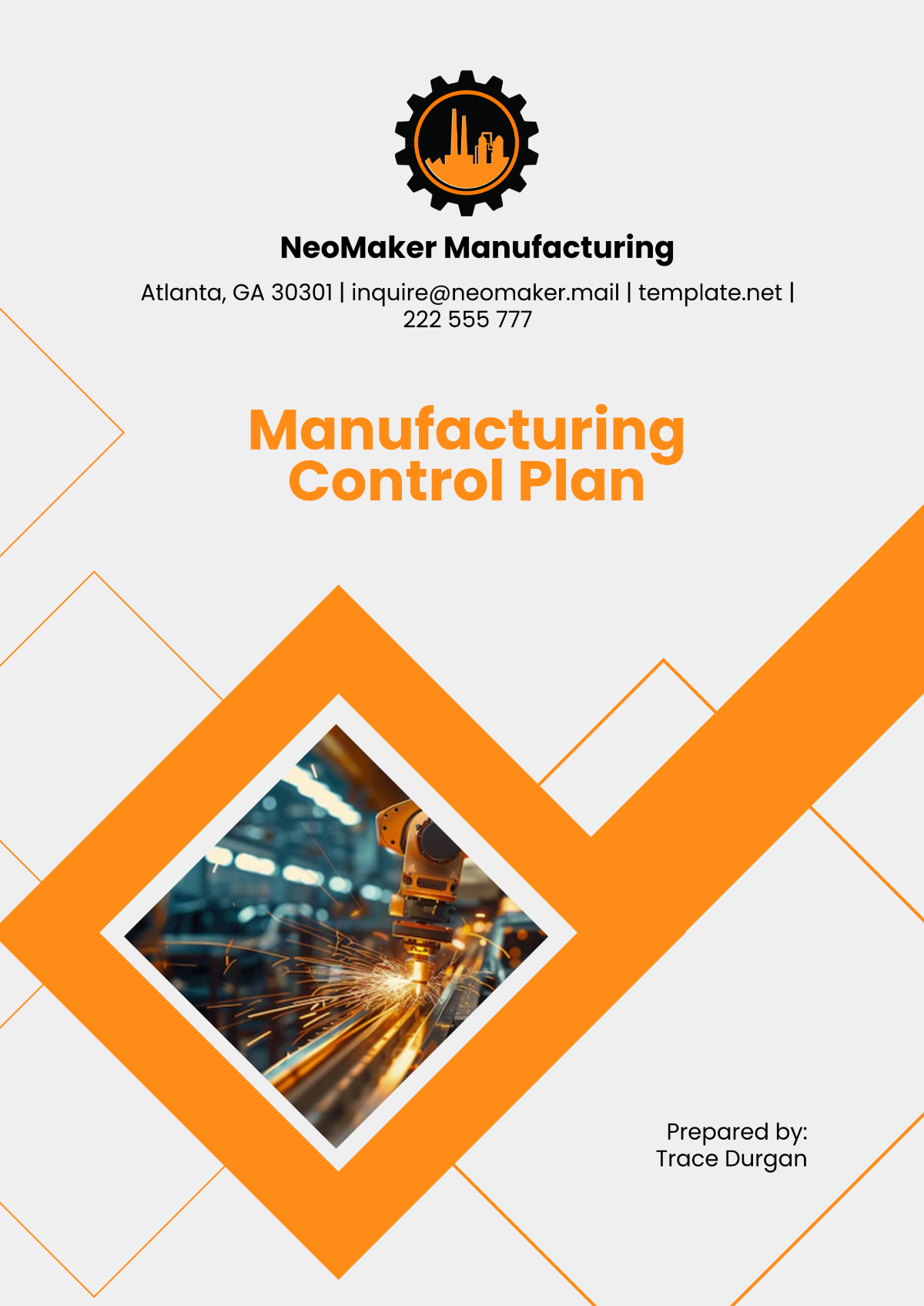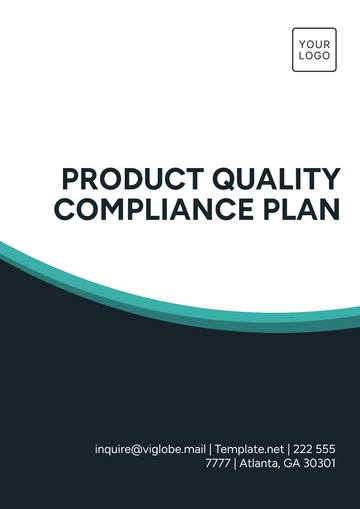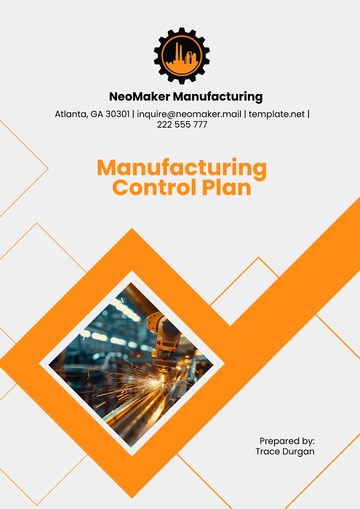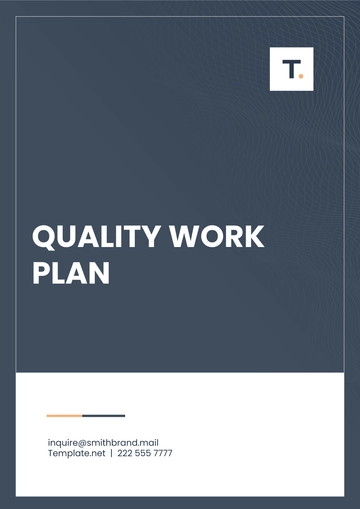Free Manufacturing Control Plan

1. Introduction
1.1 Purpose
The Manufacturing Control Plan (MCP) is a foundational document that ensures consistency, quality, and compliance throughout the manufacturing lifecycle. The plan outlines methods and practices for controlling all critical variables involved in production—from material receipt through to the final product. The purpose of the MCP is to safeguard against defects, reduce waste, increase efficiency, and provide a reliable process that consistently delivers products that meet or exceed customer expectations. The strategic objective is to maintain a competitive edge by implementing a systematic approach to production control, ensuring that manufacturing meets high standards of safety, quality, and environmental sustainability.
This document serves as a guide for all employees and stakeholders involved in the production process, providing clear directives for ensuring optimal quality and operational performance across all stages. At [Your Company Name], we place the highest priority on meeting the evolving needs of our customers, and the MCP is a key part of achieving this objective.
1.2 Scope
The Manufacturing Control Plan applies to all operational departments within [Your Company Name], including raw material procurement, production, testing, packaging, and logistics. The scope encompasses all product types and production lines, starting from the first raw material received and ending with the product shipped to customers. It includes activities like vendor quality assurance, materials inspection, process monitoring, finished product inspections, and post-production analysis.
The plan also covers adherence to all regulatory, environmental, and safety standards, including ISO certifications, safety regulations, and environmental compliance measures. As [Your Company Name] grows and evolves, the MCP will be regularly reviewed and updated to include any new technologies, materials, or methods implemented in production. This ongoing review process ensures that the plan adapts to both market trends and innovations in manufacturing, providing an adaptable and scalable framework for future developments.
1.3 Responsibilities
A successful manufacturing control strategy requires a dedicated and coordinated approach from every department. The responsibilities of key personnel involved in the control plan include:
Quality Assurance Team: Responsible for overseeing the implementation and enforcement of all quality control procedures. The team ensures that manufacturing processes adhere to standards, conducts regular audits, investigates any deviations, and implements corrective actions.
Production Team: The frontline workers who operate the machinery, assemble the products, and oversee the daily operations of the manufacturing process. They must follow strict protocols to ensure that the process flows smoothly and efficiently.
Engineering Team: Works closely with the production and quality assurance teams to monitor and improve processes. They focus on optimizing machinery and equipment, troubleshooting issues, and ensuring that all systems run within the required specifications.
Management: Provides leadership, resources, and direction. Senior management ensures that the resources needed for the implementation of the control plan are allocated efficiently, and they are responsible for approving updates to the plan, ensuring that it aligns with company goals and customer requirements.
Each team has a critical role in ensuring the manufacturing process runs smoothly, and their efforts are collectively focused on the continuous improvement of the process.
2. Process Overview
2.1 Manufacturing Process Description
The manufacturing process at [Your Company Name] consists of a series of interconnected steps, each designed to ensure that the final product adheres to the highest quality standards. The process begins with the procurement of raw materials from carefully selected suppliers who meet stringent quality and sustainability criteria. Once the materials are received, they undergo thorough inspection to ensure compliance with predefined specifications before they are released for use in production.
Production itself is a highly controlled environment, where sophisticated equipment and skilled operators work in tandem to transform raw materials into finished goods. Each stage of production is closely monitored to ensure that all process parameters are within the defined range. This includes tracking temperatures, cycle times, pressure levels, and other critical factors. Additionally, continuous monitoring of equipment health is performed to prevent any potential breakdowns that could impact production efficiency or quality.
Upon completion of the manufacturing process, products undergo rigorous testing and inspections to verify that they meet the required performance specifications. This includes dimensional measurements, strength tests, and functional performance evaluations. Finally, before products are packaged and shipped, final inspections ensure that they meet customer expectations, and that packaging is secure and properly labeled.
2.2 Key Manufacturing Objectives
The primary objectives of the Manufacturing Control Plan are designed to align with [Your Company Name]'s commitment to delivering exceptional quality while minimizing waste and inefficiencies. These objectives are measured using key performance indicators (KPIs) and are essential for maintaining a competitive position in the market. The specific objectives are:
Process Yield: Achieving a process yield rate of [95%] or higher ensures that the majority of products produced are defect-free and meet all specifications. Maintaining a high process yield reduces the costs associated with rework and scrap.
Defect Rate: The goal is to maintain a defect rate of less than [2%], with all defective products investigated for root causes. This ensures that corrective actions are taken immediately to prevent further occurrences and minimize product failure in the market.
Customer Satisfaction: With a target of [98%] customer satisfaction, the company strives to maintain positive relationships with customers by meeting their expectations for product quality, delivery timelines, and service.
On-Time Delivery: To ensure that customer expectations are met, [Your Company Name] aims for an on-time delivery rate of at least [99%], with accurate forecasting and efficient logistics management.
Achieving these objectives requires coordinated efforts across all teams involved in the production and supply chain, from procurement through to final delivery.
3. Control Plan Structure
3.1 Input Control Methods
Input control plays a crucial role in maintaining high product quality. Only raw materials that meet the predefined specifications are allowed to enter the manufacturing process. This ensures that any defects or variations are not introduced at the outset.
The key methods employed for input control include:
Supplier Evaluation: All suppliers are thoroughly evaluated based on quality, reliability, and sustainability practices. Supplier audits are conducted annually, and a performance scorecard is maintained to track any discrepancies.
Incoming Material Inspection: Upon arrival, all raw materials undergo an inspection to verify compliance with specified requirements. This inspection includes checking material certifications, performing dimensional measurements, and conducting strength tests to ensure that the materials meet the required performance criteria.
Inventory Management: [Your Company Name] utilizes an advanced inventory management system that tracks raw materials and components in real time. This system helps prevent overstocking and shortages and ensures that only materials that have been tested and approved are used in production.
By rigorously controlling the quality of inputs, we ensure that the production process can proceed without introducing variability that could compromise product quality.
3.2 Process Monitoring and Control
Effective process monitoring and control are essential for maintaining production consistency and minimizing errors. Process variables, such as temperature, pressure, cycle time, and material flow, must be carefully managed to ensure that every product produced meets the required specifications.
The following methods are used to monitor and control the manufacturing process:
Statistical Process Control (SPC): By using control charts and process capability studies, SPC helps identify any process variations that might lead to defects. Control charts track important parameters, such as temperature or pressure, and any deviation from the standard triggers an alert for corrective action.
Real-time Monitoring: IoT sensors are embedded in key production equipment, providing real-time data about machine health, product dimensions, and process variables. This allows operators to identify potential issues immediately and make adjustments without interrupting production.
Root Cause Analysis: Whenever a deviation or defect is detected, a root cause analysis is conducted. This involves analyzing historical data, reviewing equipment performance, and examining operator actions to pinpoint the cause of the problem and prevent it from recurring.
By combining these methods, [Your Company Name] ensures that every aspect of the manufacturing process is continuously optimized, keeping defects to a minimum.
3.3 Output Validation
Output validation ensures that finished products meet all specifications and customer requirements. The validation process includes several stages of testing and inspection, each designed to catch any potential issues before products leave the facility.
The following validation methods are employed:
Dimensional Testing: All finished products are measured to ensure that they adhere to the specified tolerances. This involves using precision instruments like coordinate measuring machines (CMM) to verify the product’s physical dimensions against the design specifications.
Functional Testing: Random samples of the finished product undergo functional testing, which simulates real-world conditions. This ensures that the product performs as intended under normal use.
Visual Inspection: A visual inspection is conducted to check for cosmetic defects, such as scratches, dents, or discoloration. Any product found with visual defects is immediately removed from the production line.
These validation steps ensure that only products meeting [Your Company Name]'s strict quality standards are released to customers.
4. Key Components of the Control Plan
4.1 Process Flowchart
A process flowchart is a visual representation of the entire manufacturing process, outlining each step from raw material receipt to final packaging. It helps operators and engineers understand the relationships between different stages and the key control points where inspections, tests, and checks must occur.
The flowchart includes all critical process steps, such as:
Material Receiving and Inspection
Preparation and Setup
Main Production Process
Inspection and Testing
Packaging and Shipping
Having a clear flowchart enables easy identification of bottlenecks and inefficiencies in the production process, allowing for targeted process improvements.
4.2 Product Characteristics
These characteristics define the parameters that must be controlled to ensure the product performs as intended. Product characteristics are the primary focus of the manufacturing control plan, as they determine whether the final product meets customer expectations.
Typical characteristics include:
Mechanical Properties: Tensile strength, hardness, and fatigue resistance.
Dimensional Tolerances: Accuracy of component measurements.
Surface Quality: Smoothness, finish, and cleanliness.
Monitoring these characteristics ensures that the product functions properly in its intended environment.
4.3 Process Parameters
Critical process parameters that directly impact product quality must be carefully controlled. This includes factors like temperature, pressure, and speed, which are closely monitored during manufacturing.
Key process parameters include:
Temperature Settings: For heat treatment processes.
Pressure: In molding or injection processes.
Speed: For assembly lines or automated operations.
Deviations from these parameters can result in defective products, so tight control is necessary.
4.4 Control Methods and Tools
The control methods used to monitor and adjust process parameters are essential for ensuring the manufacturing process remains within desired specifications. The primary tools include:
Statistical Process Control (SPC): As described earlier, SPC tools like control charts are vital for monitoring process stability.
Automated Monitoring Systems: IoT devices and sensors track real-time data on equipment and processes, providing early warnings for deviations.
Inspection Jigs and Fixtures: Used to verify dimensional tolerances and product functionality at key stages of production.
These methods ensure that each step of the process is under control and optimized for quality.
5. Risk Management and Mitigation
5.1 Potential Failure Modes and Effects Analysis (PFMEA)
The Potential Failure Modes and Effects Analysis (PFMEA) is a systematic method used to evaluate and prioritize potential risks in the manufacturing process. This proactive approach helps identify failure modes that could lead to product defects, process inefficiencies, or safety hazards, and allows the team to address them before they impact production. PFMEA evaluates each failure mode based on three criteria: severity, likelihood of occurrence, and detectability. Each of these criteria is rated on a scale of [1] to [10], and the Risk Priority Number (RPN) is calculated by multiplying these ratings together. The higher the RPN, the more critical the failure mode is.
For example, a critical failure mode, such as overheating of equipment, might have a high severity rating because it can cause significant product defects, a moderate likelihood of occurrence due to regular wear and tear on equipment, and a low detectability rating if the system lacks real-time monitoring. The RPN score helps prioritize corrective actions.
PFMEA Table
Failure Mode | Potential Effect | Severity | Likelihood | Detectability | RPN |
|---|---|---|---|---|---|
Overheating of Equipment | Material properties affected, part defects | 9 | 3 | 4 | 108 |
Incorrect Material Used | Poor product quality, increased scrap rate | 8 | 4 | 3 | 96 |
Incorrect Assembly | Product failure, customer returns | 10 | 2 | 3 | 60 |
Packaging Defects | Customer dissatisfaction, potential damage during shipment | 7 | 5 | 6 | 210 |
In the example above, the Overheating of Equipment has the highest RPN, indicating it is the most critical issue and should be addressed with preventive measures such as enhanced cooling systems, regular maintenance checks, or equipment upgrades. By addressing high-RPN failure modes first, the company can significantly improve process reliability and product quality.
5.2 Preventive Actions
Preventive actions are put in place to mitigate risks identified through PFMEA and other risk assessment tools. These actions are designed to reduce the likelihood of failure modes occurring and to control their impact if they do happen. The preventive actions focus on improving system robustness, increasing process stability, and optimizing the training of operators and technicians to identify potential problems early on.
Key Preventive Actions:
Routine Equipment Maintenance and Calibration: Regularly scheduled maintenance reduces the risk of machine malfunctions or inefficiencies. This includes recalibrating machinery and replacing worn-out components before they fail.
Operator Training and Certification: Ongoing training ensures that operators are well-equipped to handle machinery, identify issues early, and follow correct procedures, reducing the likelihood of human error.
Supplier Quality Assurance: Strengthening the selection and auditing of suppliers helps ensure that only the best materials are used in production, thus reducing defects caused by low-quality inputs.
Automation of Critical Processes: Automation reduces variability and human error, especially in high-precision tasks, thus minimizing defects in the final product.
Preventive actions are tracked with periodic reviews and audits to ensure that they remain effective and that the manufacturing process continues to improve. These actions are revisited and updated as necessary when new risks are identified or production technologies change.
6. Documentation and Records Management
6.1 Reporting Requirements
A robust documentation and reporting system is essential for maintaining transparency and traceability throughout the manufacturing process. Regular reporting ensures that any deviations or non-conformances are identified and addressed quickly, and that the process remains compliant with industry regulations. Reports must also be aligned with quality assurance objectives to monitor the effectiveness of the manufacturing control plan.
Types of Reports:
Production Reports: These reports track daily production metrics, including the total output, defect rates, downtime, and process deviations. They also capture the number of units produced per shift and any variations from the production schedule. This allows managers to quickly identify areas of inefficiency or issues that need attention.
Example:
Daily Production Summary: A report detailing the total number of units produced, total downtime hours, and the number of defects detected. This report is usually submitted at the end of each shift.
Inspection Reports: These reports document the results of quality inspections performed on products throughout the manufacturing process. They include measurements of critical product characteristics such as dimensions, weight, strength, and finish. Any non-conformance is flagged and analyzed for root cause.
Example:
Dimensional Inspection Report: A report listing the actual measurements of the components compared to their specifications, with pass/fail indicators.
Corrective Action Reports: When deviations or defects are identified, corrective actions are taken, and this report documents the steps taken to rectify the problem. These reports include details on root cause analysis, corrective measures implemented, and preventive actions to avoid recurrence.
Example:
Root Cause and Corrective Action Report: A document explaining the issue discovered, its cause, and the steps taken to correct it, including any procedural changes or equipment upgrades required.
6.2 Revision Control
Revision control is an important aspect of documentation management that ensures all documents are kept up-to-date and that changes are properly tracked. This includes changes to the control plan, production processes, or quality assurance methods. Proper revision control ensures that all personnel are working from the most current documents, thus minimizing errors caused by outdated information.
Every document is assigned a version number, and all changes are tracked through revision histories. In addition, access control is implemented to prevent unauthorized changes and ensure that modifications are only made by authorized personnel.
For example, when a new version of the Manufacturing Control Plan is released, it might contain updated process parameters or new compliance requirements based on regulatory changes. All affected stakeholders are notified, and obsolete versions are archived to maintain a record of the evolution of the plan.
6.3 Data Storage and Retention
Data storage and retention are critical for maintaining the traceability of manufacturing processes. All records and reports, including inspection results, production data, and corrective action reports, must be stored in a secure and organized manner.
At [Your Company Name], we follow strict data retention policies that ensure compliance with regulatory and industry standards, including ISO and FDA regulations, where applicable. Data is stored digitally and physically, with backups maintained to ensure long-term availability.
Documents related to product quality, such as inspection records and testing data, are retained for a minimum of [5] years, as this is the industry standard for traceability in many sectors. However, certain critical documents may be kept for longer periods, depending on the product and customer requirements. Secure access controls ensure that only authorized personnel can access sensitive data.
7. Continuous Improvement Measures
7.1 Feedback Mechanisms
Feedback mechanisms are essential for continuous improvement and are used to capture insights from internal and external stakeholders. Feedback from customers, employees, and suppliers helps identify areas of the process that can be optimized for better performance. This feedback is incorporated into the manufacturing control plan as part of the company's commitment to continuous improvement.
Types of Feedback:
Customer Feedback: Customers provide valuable information on product quality, delivery times, and service. Feedback from customer surveys, returns, and warranty claims can identify patterns in product defects or areas where process improvements are needed.
Employee Feedback: Operators and technicians are often the first to notice inefficiencies, equipment malfunctions, or areas where the process could be streamlined. Feedback from these team members is actively sought through surveys and regular team meetings.
Supplier Feedback: Suppliers can provide insight into material quality, delivery timelines, and potential improvements in raw material sourcing. Collaborating with suppliers helps enhance the overall efficiency and quality of the supply chain.
Customer complaints, product returns, or quality issues are regularly reviewed to determine root causes and initiate process changes. Regular management reviews ensure that feedback is acted upon and that improvements are made in a timely manner.
7.2 Metrics and Key Performance Indicators (KPIs)
KPIs are measurable values that provide insight into the efficiency, effectiveness, and overall performance of the manufacturing process. These indicators are used to track whether the company is achieving its quality objectives, meeting production targets, and adhering to schedules. Regular KPI reviews allow for timely interventions when performance deviates from desired targets.
Key KPIs include:
Process Yield: Measures the percentage of products that meet quality standards without requiring rework or scrap. The target process yield at [Your Company Name] is [95%] or higher. If the yield drops below this target, corrective actions are implemented to identify and resolve the root cause.
Defect Rate: The defect rate is calculated as the percentage of products that fail quality inspection. The goal is to keep the defect rate below [2%]. A high defect rate can indicate issues with process stability or material quality.
Customer Satisfaction: Measured through surveys and customer feedback, the goal is to maintain a customer satisfaction rate of at least [98%]. This metric is crucial to retaining customers and improving brand reputation.
On-Time Delivery Rate: This KPI tracks the percentage of orders delivered to customers on time. The goal is to achieve an on-time delivery rate of [99%] or higher, which ensures customer satisfaction and reduces the likelihood of product delays or customer complaints.
KPI | Target | Measurement Method |
|---|---|---|
Process Yield | 95% or higher | Product audits, quality checks |
Defect Rate | Less than 2% | Inspection results, returns |
Customer Satisfaction | 98% satisfaction rate | Surveys, feedback analysis |
On-Time Delivery Rate | 99% or higher | Delivery tracking systems |
Each of these KPIs is tracked regularly, and corrective actions are implemented if performance deviates from the desired targets.
8. Conclusion
The Manufacturing Control Plan serves as a blueprint for maintaining high-quality standards, ensuring product consistency, and optimizing production efficiency at [Your Company Name]. This comprehensive plan integrates critical elements such as process controls, risk management, documentation, and continuous improvement. By adhering to the strategies outlined in this control plan, the company ensures that products meet customer requirements, comply with industry standards, and contribute to overall business success.
Continuous monitoring, data-driven decision-making, and collaboration between all stakeholders foster an environment of ongoing improvement, enabling [Your Company Name] to remain competitive and deliver high-quality products.
By maintaining a strong focus on quality control, risk management, and performance metrics, the company not only meets but exceeds customer expectations, ultimately ensuring long-term success in the marketplace.
- 100% Customizable, free editor
- Access 1 Million+ Templates, photo’s & graphics
- Download or share as a template
- Click and replace photos, graphics, text, backgrounds
- Resize, crop, AI write & more
- Access advanced editor
Ensure consistent product quality with the Manufacturing Control Plan Template from Template.net. Editable and customizable, this template allows you to create control plans that monitor and manage quality assurance throughout your manufacturing process. Use the AI Editor Tool to fine-tune the plan and meet your company's specific standards.
You may also like
- Finance Plan
- Construction Plan
- Sales Plan
- Development Plan
- Career Plan
- Budget Plan
- HR Plan
- Education Plan
- Transition Plan
- Work Plan
- Training Plan
- Communication Plan
- Operation Plan
- Health And Safety Plan
- Strategy Plan
- Professional Development Plan
- Advertising Plan
- Risk Management Plan
- Restaurant Plan
- School Plan
- Nursing Home Patient Care Plan
- Nursing Care Plan
- Plan Event
- Startup Plan
- Social Media Plan
- Staffing Plan
- Annual Plan
- Content Plan
- Payment Plan
- Implementation Plan
- Hotel Plan
- Workout Plan
- Accounting Plan
- Campaign Plan
- Essay Plan
- 30 60 90 Day Plan
- Research Plan
- Recruitment Plan
- 90 Day Plan
- Quarterly Plan
- Emergency Plan
- 5 Year Plan
- Gym Plan
- Personal Plan
- IT and Software Plan
- Treatment Plan
- Real Estate Plan
- Law Firm Plan
- Healthcare Plan
- Improvement Plan
- Media Plan
- 5 Year Business Plan
- Learning Plan
- Marketing Campaign Plan
- Travel Agency Plan
- Cleaning Services Plan
- Interior Design Plan
- Performance Plan
- PR Plan
- Birth Plan
- Life Plan
- SEO Plan
- Disaster Recovery Plan
- Continuity Plan
- Launch Plan
- Legal Plan
- Behavior Plan
- Performance Improvement Plan
- Salon Plan
- Security Plan
- Security Management Plan
- Employee Development Plan
- Quality Plan
- Service Improvement Plan
- Growth Plan
- Incident Response Plan
- Basketball Plan
- Emergency Action Plan
- Product Launch Plan
- Spa Plan
- Employee Training Plan
- Data Analysis Plan
- Employee Action Plan
- Territory Plan
- Audit Plan
- Classroom Plan
- Activity Plan
- Parenting Plan
- Care Plan
- Project Execution Plan
- Exercise Plan
- Internship Plan
- Software Development Plan
- Continuous Improvement Plan
- Leave Plan
- 90 Day Sales Plan
- Advertising Agency Plan
- Employee Transition Plan
- Smart Action Plan
- Workplace Safety Plan
- Behavior Change Plan
- Contingency Plan
- Continuity of Operations Plan
- Health Plan
- Quality Control Plan
- Self Plan
- Sports Development Plan
- Change Management Plan
- Ecommerce Plan
- Personal Financial Plan
- Process Improvement Plan
- 30-60-90 Day Sales Plan
- Crisis Management Plan
- Engagement Plan
- Execution Plan
- Pandemic Plan
- Quality Assurance Plan
- Service Continuity Plan
- Agile Project Plan
- Fundraising Plan
- Job Transition Plan
- Asset Maintenance Plan
- Maintenance Plan
- Software Test Plan
- Staff Training and Development Plan
- 3 Year Plan
- Brand Activation Plan
- Release Plan
- Resource Plan
- Risk Mitigation Plan
- Teacher Plan
- 30 60 90 Day Plan for New Manager
- Food Safety Plan
- Food Truck Plan
- Hiring Plan
- Quality Management Plan
- Wellness Plan
- Behavior Intervention Plan
- Bonus Plan
- Investment Plan
- Maternity Leave Plan
- Pandemic Response Plan
- Succession Planning
- Coaching Plan
- Configuration Management Plan
- Remote Work Plan
- Self Care Plan
- Teaching Plan
- 100-Day Plan
- HACCP Plan
- Student Plan
- Sustainability Plan
- 30 60 90 Day Plan for Interview
- Access Plan
- Site Specific Safety Plan






